Creating a Montessori at Home environment is a thoughtful and rewarding journey that allows parents to bring the proven principles of the Montessori Method into everyday life. Imagine a home where your child feels confident to explore, a space that nurtures independence, curiosity, and creativity. By adopting Montessori teachings, you can transform your living space into an environment that fosters learning and growth naturally and joyfully.
Dr. Maria Montessori’s philosophy emphasizes hands-on learning, self-discipline, and respect for a child’s natural developmental process. This approach is ideal for parents who want to go beyond traditional educational methods and create a more holistic, child-centered learning experience. Whether you’re planning a dedicated Montessori homeschool curriculum or simply incorporating Montessori techniques at home, the core principles remain the same:
- Create a prepared environment where everything has a purpose and is accessible to your child.
- Focus on practical life activities and sensory learning to build foundational skills.
- Guide rather than instruct, allowing your child to lead their learning journey.
Why Implement Montessori at Home?
The benefits of Montessori education at home extend far beyond academics. Children in a Montessori setting develop cognitive abilities and essential life skills such as adaptability, problem-solving, and emotional intelligence. The home environment offers the flexibility to tailor learning experiences to your child’s needs and interests.
By implementing Montessori at Home, you can:
- Foster independence by involving your child in everyday tasks like cooking, cleaning, and organizing.
- Encourage focus and discipline through thoughtfully designed activities and routines.
- Cultivate a love for learning by providing hands-on materials that are both engaging and educational.
For instance, a Montessori playroom might include open shelving with carefully curated toys, DIY materials like counting beads, or simple tools like a child-sized broom. These setups empower children to explore their environment freely while learning essential concepts like order, responsibility, and creativity.
What to Expect in This Guide
This comprehensive guide will take you step by step through creating a Montessori-friendly home environment. You’ll learn how to:
- Set up a Montessori-style home that adapts to your child’s needs.
- Integrate practical life activities and sensory tools for learning and development.
- Design a flexible yet structured routine that mimics a Montessori homeschool curriculum.
- Create DIY Montessori materials that are affordable and effective.
Whether you’re a seasoned educator or new to the concept, this guide will provide actionable tips and inspiration to help you seamlessly implement Montessori techniques at home. Let’s begin this transformative journey toward raising confident, capable, and curious children!
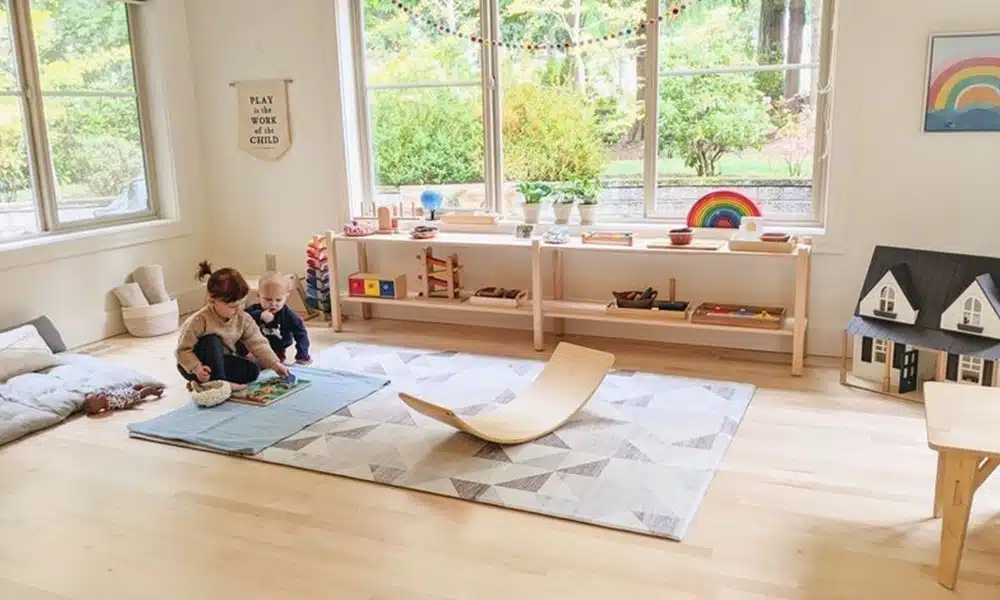
Gaining Insight into Montessori Education and Its Key Concepts
Montessori education is a revolutionary approach to learning that prioritizes children’s individual needs, interests, and development. Dr. Maria Montessori’s philosophy is built on the belief that children are naturally curious and capable of directing their learning when provided with the right environment and tools. Implementing Montessori at Home allows parents to bring these transformative principles into their daily lives, fostering a love of learning that lasts a lifetime.
What Is the Montessori Philosophy?
The Montessori Method is centered on child-led learning, where children can freely explore their interests at their own pace. This philosophy respects individuality and emphasizes the role of a thoughtfully prepared environment. Unlike traditional education, where instruction is often teacher-directed, Montessori creates opportunities for children to develop independence and self-discipline.
Some fundamental principles of the Montessori philosophy include:
- Freedom within limits: Children have the autonomy to choose activities but within a structured framework.
- Hands-on learning: Materials like counting beads, sandpaper letters, and sensory tools encourage active engagement.
- Respect for the child: Understanding and valuing each child’s unique developmental timeline.
By embracing these principles, parents can create a home environment where children thrive emotionally, socially, and academically.
How Montessori Encourages Independent Learning
One of the defining features of Montessori teachings is the emphasis on independent learning. By providing child-sized furniture, accessible materials, and self-correcting tools, children can work independently without constant adult intervention. This setup cultivates problem-solving skills and self-confidence.
For example:
- Practical activities like pouring water or preparing snacks help develop coordination and independence.
- Learning tools such as puzzles or matching games foster concentration and logical thinking.
When implementing Montessori techniques at home, parents act as guides, offering support when needed but allowing children to take charge of their learning journey. This balance is crucial for nurturing autonomy and self-motivation.
Why the Right Environment Helps Kids Learn Better
In Montessori, the environment is often called the “third teacher.” A Montessori-friendly environment is carefully curated to inspire exploration and creativity while minimizing distractions.
Key elements of such an environment include:
- Order and simplicity: A clutter-free space helps children focus.
- Accessibility: Low shelves and child-sized tools encourage self-reliance.
- Natural materials: Wooden toys and neutral tones create a calm, inviting atmosphere.
By integrating these elements, parents can turn their homes into spaces where children feel empowered to explore, learn, and grow.
Essential Elements of Montessori Education
Creating a successful Montessori at Home environment requires understanding its essential components. These elements form the foundation of the Montessori philosophy and can be adapted to suit children of all ages.
Understanding the Purpose of a Prepared Montessori Space
A prepared environment is a hallmark of Montessori education. It’s a space that promotes independence, concentration, and self-directed learning. Every item in the space has a purpose and is arranged to encourage exploration.
Features of a well-prepared Montessori space include:
- Defined zones: Separate areas for reading, practical life, and creative play.
- Child-sized furniture: Children can use tables, chairs, and shelves comfortably.
- Age-appropriate materials: Tools and toys tailored to the child’s developmental stage.
Example Setup:
- In a Montessori playroom, toys are arranged on open shelves, allowing the child to select and return items independently.
Self-Directed Learning Through Auto Education
Dr. Montessori introduced the concept of “auto education,” where children teach themselves through engaging materials and activities. This principle is integral to Montessori homeschool programs and home setups.
Examples of auto-education tools include:
- Counting beads: These teach math concepts like addition and subtraction through hands-on practice.
- Sandpaper letters: Help children connect letter shapes with sounds, promoting literacy skills.
- Sensorial materials: Enhance a child’s ability to classify and understand their surroundings.
Parents can replicate this at home by providing self-correcting tools that allow children to independently identify and fix their mistakes.
The Role of the Montessori Educator at Home
In a Montessori at Home setup, parents play the role of observers and facilitators rather than instructors. This shift in mindset is crucial for creating a thriving learning environment.
As a Montessori educator at home, your responsibilities include:
- Observing: Understanding your child’s needs, interests, and challenges.
- Preparing the environment: Ensuring that materials and spaces are aligned with developmental goals.
- Offering guidance: Providing support only when necessary to encourage problem-solving and resilience.
By fulfilling these roles, parents can create a nurturing space that mirrors the values of Montessori education while respecting the unique dynamics of home life.
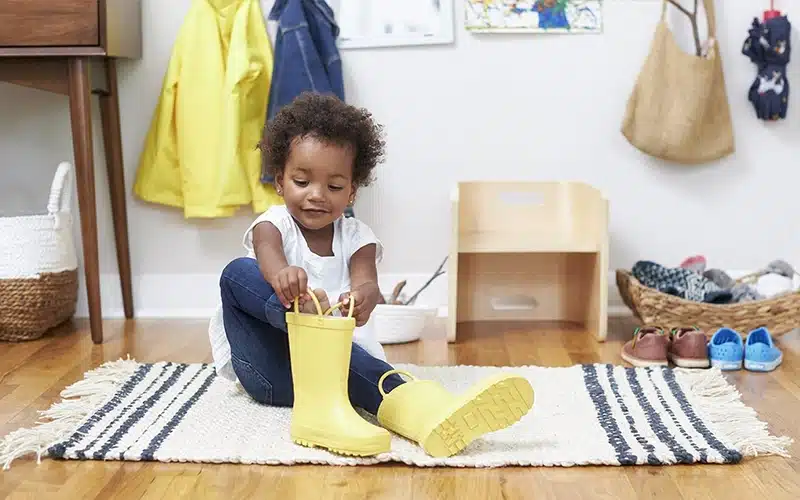

How to Create a Montessori-Style Home
Bringing the Montessori Method at home involves more than just creating a space—it’s about fostering an environment where children can develop essential life skills, explore their interests, and grow at their own pace. A Montessori-style home is functional, inviting, and designed to support self-directed learning and independence.
Teaching Life Skills Through Everyday Activities
Practical life activities are a cornerstone of the Montessori teachings, as they help children build confidence, coordination, and responsibility. These activities are easy to integrate into your daily routine and teach essential skills beyond academics.
Examples of Practical Life Activities:
- Cooking: Allow your child to wash vegetables, pour ingredients, or knead dough. This enhances hand-eye coordination and builds a sense of accomplishment.
- Cleaning: Tasks like sweeping the floor with a child-sized broom or wiping a table instill discipline and pride in maintaining order.
- Gardening: Teach responsibility by letting your child water plants or plant seeds in the garden.
Incorporating these activities into your Montessori at Home schedule creates opportunities for learning while bonding as a family.
Sensory Tools and Materials to Try at Home
Sensory learning materials are central to Montessori education at home. These tools engage the senses to help children refine their perception and understanding of the world.
Ideas for Sensory Tools:
- Texture boards: Create boards with sandpaper, fabric, and other materials to help children differentiate textures.
- Sound cylinders: Fill small containers with materials like rice, beans, or beads to let children match sounds.
- Montessori-inspired playdough kits: Allow your child to explore shapes and patterns using molds and rollers.
Integrating these tools into your Montessori home setup will enhance your child’s sensory development and critical thinking skills.
Tips for Setting Up Learning Spaces Your Kids Will Love
Designing a Montessori play area requires thoughtful planning to ensure the space is engaging and accessible. Key tips include:
- Keep it organized: Use open shelving with labeled bins to make materials easy to find and return.
- Use natural elements: Wooden furniture, plants, and neutral colors create a calming environment.
- Create defined zones: Separate spaces for reading, art, and practical life activities help children focus.
Example Setup for a Montessori Playroom:
| Zone | Purpose | Materials |
|---|---|---|
| Reading Corner | Encourage a love for books | Low shelves, bean bags, picture books |
| Art Area | Foster creativity and expression | Paints, crayons, recycled paper |
| Practical Life | Teach essential life skills | Child-sized tools like a broom |
DIY Montessori Materials for Your Home
Creating DIY Montessori materials is an affordable and rewarding way to bring Montessori principles into your home. These materials support independent learning, fine motor skills, and problem-solving.
Affordable Ways to Make Montessori Tools at Home
You don’t need expensive equipment to implement Montessori concepts at home. Many tools can be created using everyday household items.
DIY Ideas for Montessori Materials:
- Counting beads: String colorful beads onto pipe cleaners to teach counting, addition, and subtraction.
- Shape sorters: Use cardboard to cut out shapes and matching slots for sorting.
- Sensory bins: Fill a bin with rice, small toys, and objects for sorting and exploration.
These simple projects save money and allow you to customize materials for your child’s developmental stage.
Crafting Montessori Toys and Learning Aids
Homemade Montessori toys are another great way to engage your child’s senses and curiosity. For instance:
- Puzzle boards: Use foam or wood to create simple puzzles with large, easy-to-handle pieces.
- Memory matching games: Print matching cards with pictures of animals, shapes, or everyday objects.
- Color tablets: Paint wooden blocks in pairs of colors to encourage matching and sorting.
These tools help integrate Montessori techniques at home, making learning fun and interactive.
Why DIY Montessori Materials Are Effective
DIY materials reflect the core of the Montessori Method: simplicity, functionality, and purpose. Involving children in creating these tools gives them a sense of ownership and pride in their learning environment.
Pro Tip: Rotate materials weekly to keep the activities fresh and engaging.
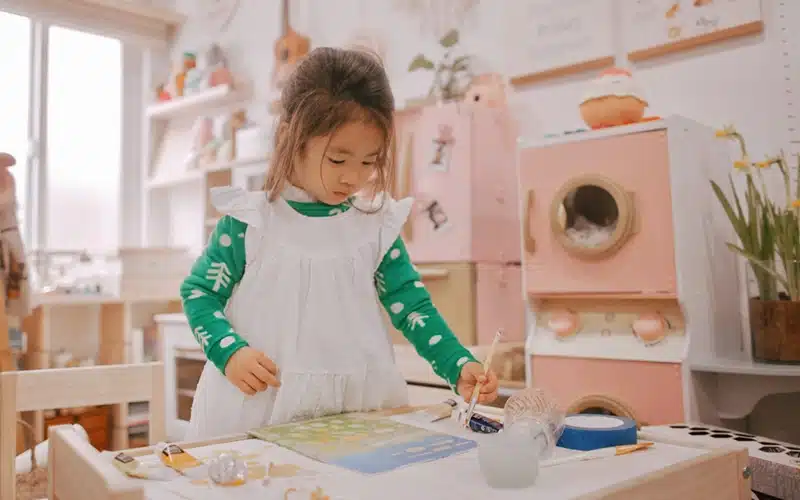
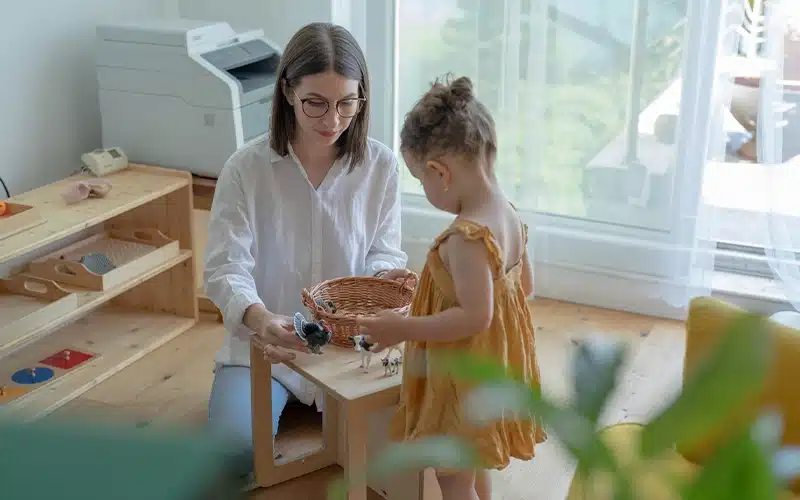

Adding Montessori Basics to Your Daily Life
Integrating Montessori basics into daily life is the cornerstone of a successful Montessori at Home experience. It’s about transforming everyday routines into learning opportunities and creating a supportive environment where children feel empowered to explore and grow. Parents can seamlessly weave education into their children’s daily activities by adopting Montessori techniques at home while fostering independence and curiosity.
How to Organize Your Home for Montessori
A well-organized home is essential for implementing the Montessori Method at home. Each room should be intentionally designed to promote independence and self-directed learning.
Room-by-Room Montessori Setup:
| Room | Key Montessori Features | Examples of Implementation |
|---|---|---|
| Kitchen | Accessible shelves and tools for child involvement in meal preparation | Low shelves for utensils, a child-safe knife for slicing fruits |
| Bedroom | A calm, uncluttered space that encourages rest and responsibility | Floor bed, child-sized wardrobe for independent dressing |
| Living Room | A shared area for learning and play with Montessori-inspired materials | Open shelving for books, puzzles, and Montessori toys |
| Bathroom | Tools for teaching hygiene and independence | Step stool, child-friendly soap dispenser |
Creating an intentional Montessori home setup empowers your child to take ownership of their space and develop essential life skills.
Helping Kids Build Focus with Montessori Activities
Focus is a foundational skill that supports all areas of development. Children learn to concentrate for extended periods through carefully selected Montessori activities, building cognitive and emotional resilience.
Examples of Focus-Building Montessori Activities:
- Practical Life Tasks: Activities like sweeping, pouring water, or peeling vegetables teach patience and attention to detail.
- Sensorial Exercises: Matching textures or identifying scents sharpens sensory perception while engaging focus.
- Bead Stringing: This acceptable motor activity requires sustained concentration and promotes creativity.
- Puzzle Work: Completing age-appropriate puzzles develops logical thinking and perseverance.
These Montessori techniques at home help your child develop focus and encourage independence and problem-solving.
Teaching Life Skills in Fun and Simple Ways
Montessori learning emphasizes practical life skills, blending education with routine activities. These tasks teach responsibility, coordination, and self-confidence:
- Laundry Sorting: Turn sorting clothes by color or size into an engaging lesson in classification.
- Gardening: Allow your child to water plants or plant seeds, fostering a sense of environmental care.
- Snack Preparation: Simple tasks like spreading butter on bread or slicing bananas teach fine motor skills.
Making life skills enjoyable ensures that children remain engaged while learning valuable lessons.
Why Rewards Aren’t Needed in Montessori Learning
One of the core principles of Montessori teachings is intrinsic motivation. Unlike traditional systems that rely on external rewards, Montessori encourages children to find satisfaction.
Why This Works in a Montessori Environment:
- Focus on Effort: Celebrate progress and persistence rather than just results.
- Encourage Self-Motivation: Children naturally love learning when not dependent on rewards.
- Foster Independence: Children learn to value their accomplishments intrinsically by eliminating rewards.
Example in Action:
If your child completes a puzzle, you might say instead of offering a treat, “You worked so carefully to finish that!” This approach reinforces their effort and keeps their motivation internal.


Parenting with a Montessori Mindset
Adopting the Montessori lifestyle is more than a teaching approach; it’s a parenting philosophy. In a Montessori at Home program, parents are seen as guides and collaborators in their child’s learning journey, fostering independence, curiosity, and mutual respect.
How to Support Your Child’s Curiosity and Growth
Children are naturally curious, and the Montessori Method encourages parents to nurture this curiosity by creating an environment that invites exploration. Here’s how you can foster growth in your child:
- Offer open-ended materials: Provide tools like building blocks, art supplies, or loose parts that inspire creativity and problem-solving.
- Be an observer: Watch your child’s actions closely to understand their interests and developmental needs.
- Provide choices: Allow your child to choose their activities within a prepared environment. This empowers them to take ownership of their learning.
Mistakes Are Okay: Letting Kids Learn from Them
One of the defining aspects of Montessori parenting is viewing mistakes as opportunities for growth rather than failures. Encouraging children to work through their challenges helps build resilience and self-confidence.
For instance:
- If a child spills water while pouring, resist the urge to intervene. Instead, hand them a towel and guide them in cleaning it up, teaching responsibility and problem-solving.
- When working on a puzzle, allow them to struggle and discover solutions independently, fostering perseverance.
By normalizing mistakes, parents create a supportive environment where children feel safe to experiment and learn at their own pace.
Teaching Self-Discipline Through Daily Routines
Incorporating structured routines into a Montessori at Home program helps children develop self-discipline and responsibility. Daily routines teach time management and encourage independence.
Montessori-Inspired Daily Routine:
| Time | Activity | Purpose |
|---|---|---|
| Morning | Independent dressing, preparing breakfast | Builds responsibility and motor skills |
| Mid-Morning | Practical life tasks (e.g., cleaning, sorting) | Encourages focus and self-reliance |
| Afternoon | Sensory activities or Montessori playroom time | Enhances creativity and concentration |
| Evening | Cleaning up, preparing for bed | Instills habits of order and routine |
By maintaining consistency, you’re helping your child develop habits that foster independence and confidence.
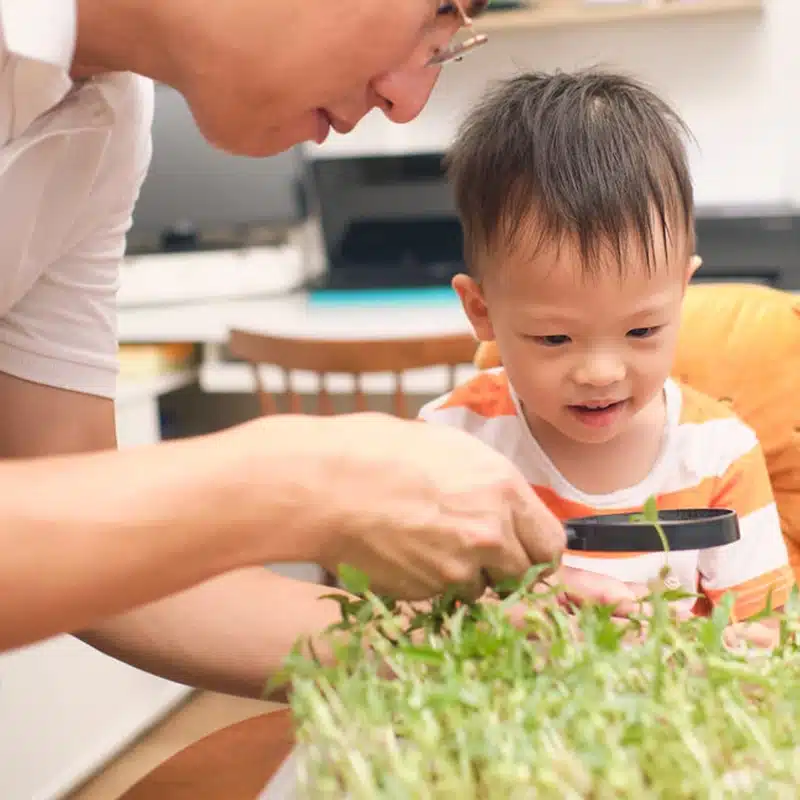

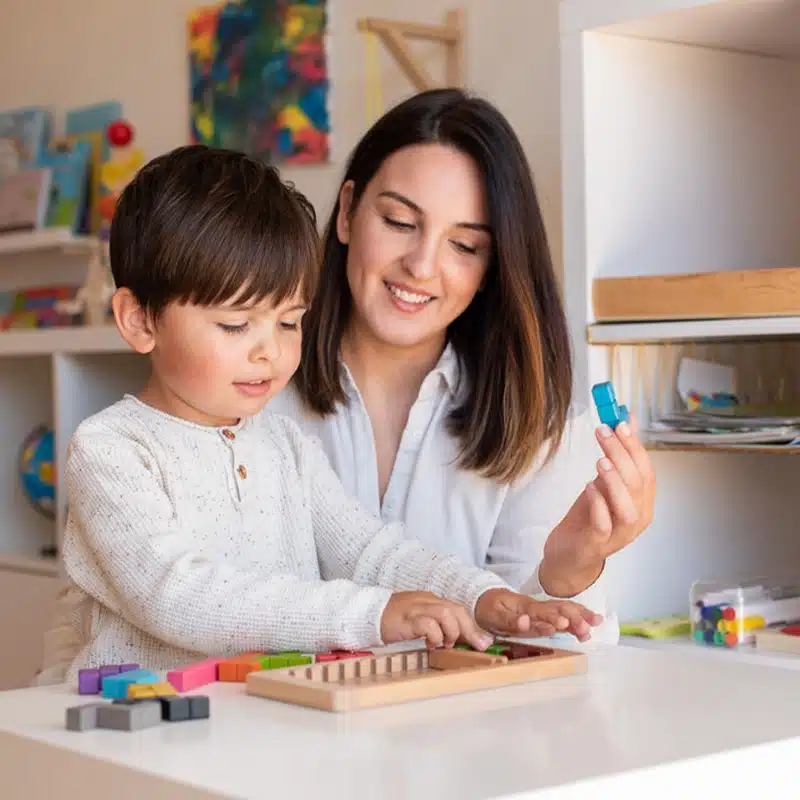
Montessori for Babies at Home
Implementing Montessori at Home for Babies creates a nurturing environment where your child can explore safely while developing essential skills. The Montessori Method adapts beautifully to even the youngest learners, from mobility to sensory engagement. A well-prepared environment encourages freedom of movement, discovery, and natural growth.
Making Your Home Safe for Babies to Explore
Safety is paramount when setting up a Montessori-friendly environment for babies. Unlike traditional spaces, a Montessori at Home setup allows freedom within safe boundaries. This freedom encourages physical development, curiosity, and problem-solving.
Essential Safety Tips for a Montessori Baby Space:
- Use soft mats: Provide a comfortable surface for crawling and rolling.
- Remove hazards: Secure furniture to walls and use corner protectors to prevent injuries.
- Organize with intention: Place baby-safe toys and Montessori materials on low shelves for easy access.
These steps ensure that your baby’s environment is secure while promoting exploration.
Using Gates and Barriers to Keep It Safe
Gates and barriers are essential tools in a Montessori at Home program for babies. They help define safe zones while allowing your child to explore freely within set boundaries.
Benefits of Gates and Barriers to Montessori Learning:
- Encourage independent movement: Babies can crawl, pull up, and practice walking without the risk of accessing unsafe areas.
- Create activity zones: Use gates to separate play areas, nap spaces, and sensory exploration corners.
- Support parent supervision: Barriers provide peace of mind, letting you observe without constantly intervening.
For example, you can use a baby gate to cordon off a low-shelving area filled with Montessori toys like stacking rings, sensory balls, and soft books. This setup encourages independent play while maintaining safety.
Why Floor Beds Work for Montessori Babies
Floor beds are a cornerstone of the Montessori Method at home, offering a baby-friendly alternative to traditional cribs. Unlike cribs that confine movement, floor beds promote independence and natural exploration.
Advantages of Floor Beds:
- Freedom of movement: Babies can explore their surroundings as they wake, fostering curiosity.
- Encourage independence: Floor beds allow babies to move unaided in and out of their sleeping area.
- Safe design: With a low height, there’s no risk of falling or climbing-related injuries.
This approach aligns perfectly with the Montessori philosophy, making it an essential part of your Montessori home setup.
Picking the Right Furniture for Little Ones
Choosing the right furniture is crucial for babies in a Montessori at-home environment. Child-sized, lightweight furniture promotes independence while ensuring safety.
Recommended Montessori Furniture for Babies:
- Low shelves: Display toys and materials at eye level for easy selection.
- Small chairs and tables: Allow your baby to sit and engage in activities comfortably.
- Mirror panels: Placed at crawling height, mirrors encourage self-recognition and movement exploration.
- Toy storage bins: Keep items organized and accessible to build responsibility early on.
By incorporating furniture designed with the Montessori Method, you create a space supporting your child’s natural development and learning.
How to Design a Cozy Bedroom for Your Baby
A Montessori-inspired bedroom for babies prioritizes simplicity, comfort, and accessibility. Focus on:
- Natural lighting: Use sheer curtains to create a soft, inviting atmosphere.
- Minimal decorations: Avoid overstimulation with neutral colors and simple designs.
- Safe materials: Use wooden toys and organic fabrics to align with Montessori teachings.
This setup transforms a bedroom into a sanctuary for rest, exploration, and growth, embodying the principles of Montessori at Home.


Montessori for Toddlers at Home
Toddlers thrive in a Montessori at Home environment that encourages exploration, independence, and hands-on learning. This stage of development is marked by a growing desire to “do it myself,” and Montessori techniques at home are designed to support this milestone.
Organizing Toys and Books for Easy Access
In a Montessori playroom, everything has its place. Organizing toys and books in an accessible and clutter-free manner empowers toddlers to make choices and take responsibility for tidying up.
Tips for Setting Up a Montessori Playroom for Toddlers:
- Use low shelves: Display materials at toddler height so they can independently choose activities.
- Rotate toys weekly: Keep a few items on display to maintain focus and interest.
- Use natural materials: Wooden toys, cloth books, and baskets align with the Montessori Method while being safe and sustainable.
Example: Arrange puzzles, stacking toys, and sensory bins in open trays or baskets, making it easy for your child to pick an activity and return it when finished.
Hanging Artwork Toddlers Can See and Enjoy
Art is an integral part of Montessori learning. You create a stimulating visual environment that encourages appreciation for beauty and creativity by hanging artwork at a toddler’s eye level.
How to Incorporate Art in a Montessori Playroom:
- Select simple, child-friendly artwork or photographs.
- Use lightweight frames with non-glass covers for safety.
- Rotate pieces regularly to match seasons or themes.
This approach fosters a connection to art while aligning with the principles of Montessori education at home.
Nature Trays: A Fun Way to Explore Seasons
Nature trays are a beloved element of the Montessori lifestyle, introducing toddlers to seasonal changes and natural materials.
Ideas for Nature Trays:
- Fall: Leaves, pinecones, acorns, and mini pumpkins.
- Spring: Flowers, small stones, and seeds for planting.
- Winter: Twigs, cotton balls (as snow), and evergreen clippings.
Each tray offers sensory exploration and a foundation for early science lessons, seamlessly integrating Montessori concepts into daily routines.
Making Potty Training Easier with Montessori Tips
Potty training in a Montessori at Home program emphasizes independence and patience.
Tips for Montessori Potty Training:
- Provide a child-sized potty or seat adapter.
- Allow your child to participate in cleanup to build responsibility.
- Use accessible storage for extra clothes and wipes.
By approaching potty training with respect and consistency, you align with the Montessori philosophy of empowering the child.
How to Handle Toddler Tantrums the Montessori Way
Tantrums are a natural part of toddler development, and the Montessori Method offers strategies for handling them with empathy and patience.
Steps to Manage Tantrums:
- Stay calm: Your reaction sets the tone for your child.
- Acknowledge emotions: Use phrases like, “I see you’re upset because…” to validate feelings.
- Offer choices: Redirect energy by providing options, such as selecting a favorite toy or activity.
Using these strategies promotes emotional regulation and resilience in your toddler while staying true to Montessori teachings.
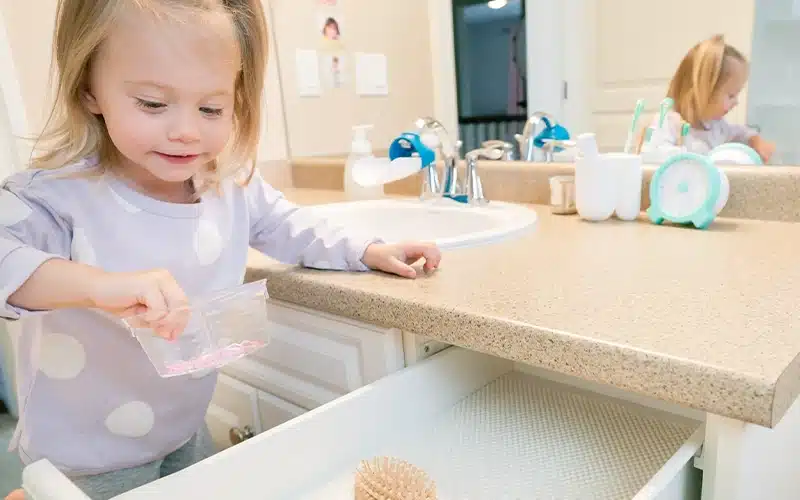
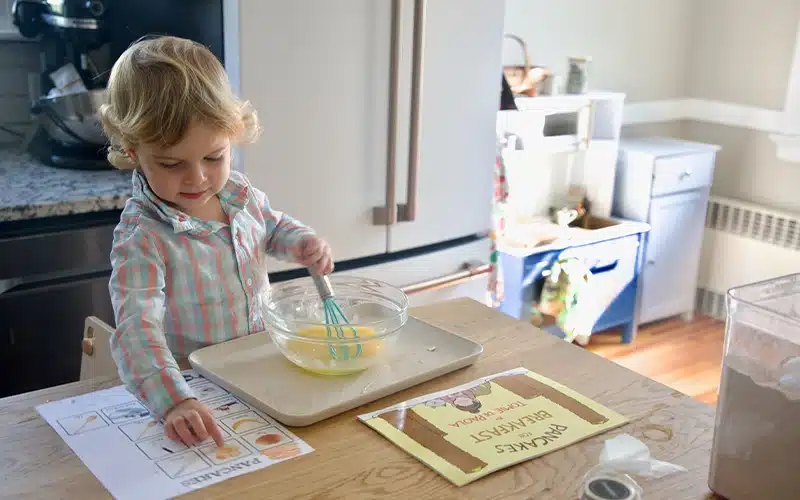
How Montessori at Home Shapes Your Child’s Growth
The impact of Montessori at Home goes beyond academic success. It nurtures a holistic development that includes cognitive, social, and emotional growth, equipping children with skills for life.
How Montessori Boosts Cognitive and Social Skills
The Montessori at Home approach supports a child’s natural cognitive and social development. Unlike traditional education systems, which often rely on rote memorization and structured interactions, the Montessori Method emphasizes hands-on learning, independence, and real-world application.
Helping Kids Build Focus and Self-Discipline
One of the hallmarks of Montessori learning is its ability to enhance a child’s focus and self-discipline through carefully curated activities and materials. In a Montessori-friendly environment, children engage with tasks that capture their attention and encourage deep concentration.
For instance, a child might work with counting beads to learn basic math concepts. These materials are designed to be challenging and rewarding, promoting persistence and focus. As children complete tasks independently, they develop the discipline to stay committed, even when faced with challenges.
Parents implementing Montessori techniques at home can nurture self-discipline by providing structured routines and consistent expectations. For example, encouraging children to clean up after completing an activity reinforces responsibility while maintaining a sense of order in the home. Over time, these practices build intrinsic motivation, helping children regulate their behavior without relying on external rewards or punishments.
Encouraging Teamwork and Social Awareness
Montessori environments naturally foster social development by encouraging collaboration and mutual respect. In a Montessori homeschool program, group tasks like preparing meals together or setting up a play area allow children to learn teamwork and empathy.
Through such interactions, children not only develop communication skills but also gain an understanding of shared responsibility. These lessons extend into social settings outside the home, preparing children to work harmoniously in teams and contribute to their communities.
Preparing Children for a Bright Future
Adopting the Montessori at Home approach equips children with skills beyond academics. The Montessori Method prepares children to thrive in a rapidly changing world by fostering independence, adaptability, and a love for learning.
Developing Lifelong Learning Habits
At its core, Montessori learning is about instilling a deep curiosity and a passion for discovery. Children are encouraged to explore topics at their own pace, diving deeply into subjects that capture their interest. This autonomy in learning builds confidence and a proactive mindset that stays with them for life.
For example, a child might spend hours exploring a nature tray filled with leaves, seeds, and twigs, asking questions and making connections. This hands-on experience deepens their understanding of the natural world and cultivates a love for inquiry and exploration.
Parents can reinforce these lifelong habits by providing access to many Montessori materials, such as puzzles, science kits, or art supplies. Rotating these tools regularly keeps activities fresh and engaging, ensuring children remain curious and motivated to learn.
Teaching Adaptability and Problem-Solving Through Montessori
The Montessori Method emphasizes problem-solving and adaptability—essential skills in today’s fast-paced world. Children can experiment, make mistakes, and find solutions independently in a Montessori at Home environment.
For instance, practical life activities like pouring water or tying shoelaces challenge children to figure out the best techniques for them. These experiences teach perseverance and creative thinking, laying a foundation for tackling more complex problems as they grow.
Parents can offer gentle guidance by observing their child’s interactions with Montessori learning tools, encouraging self-correction and innovative thinking. This approach builds adaptability and instills confidence in their ability to navigate new and unfamiliar situations.
Setting Up a Montessori-Friendly Space for School-Age Kids
As children transition into their school-age years, their needs in a Montessori at Home environment shift toward spaces that encourage focused learning, creativity, and independence. Setting up a Montessori-friendly environment for older children involves balancing structure with freedom, allowing them to take ownership of their education while nurturing their natural curiosity.
Designing a Flexible Learning Area
A dedicated learning area is essential for school-age children in a Montessori at Home program. This space should be simple, organized, and stocked with age-appropriate Montessori materials that align with their interests and developmental needs.
For example, a low shelf can hold items such as geography puzzles, science kits, and language cards, all promoting hands-on engagement. A small desk and chair allow children to work independently on writing or art projects, fostering focus and self-discipline.
Parents can further enhance this area by incorporating natural elements like plants or wooden furniture, creating a calming atmosphere that supports concentration and creativity.
Encouraging Self-Directed Learning
At this stage, children thrive when they have the autonomy to choose their activities. By implementing Montessori techniques at home, parents can guide their children to explore subjects they are passionate about while maintaining a structured routine.
For instance, a child interested in astronomy might have access to a telescope and star charts, while another drawn to art could have a collection of paints and sketchbooks. These tools encourage independent exploration and help children develop a love for learning that extends beyond the classroom.
A Montessori-friendly space for school-age kids isn’t just about academics—it’s about creating an environment that inspires curiosity and supports their growing independence.
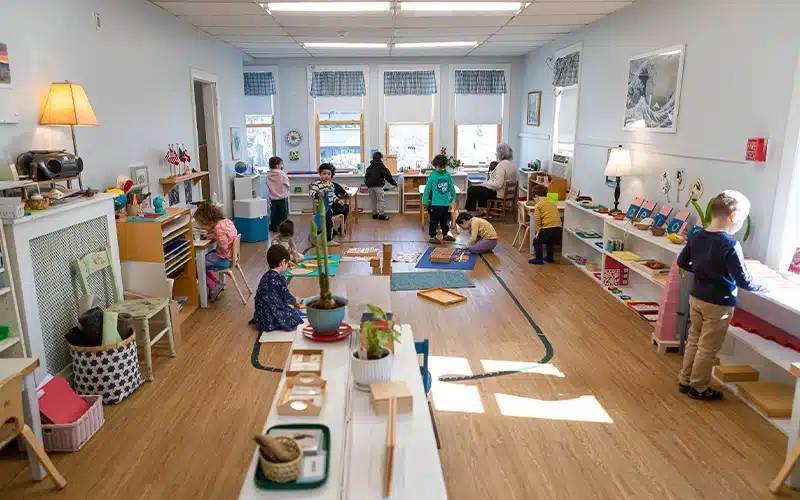
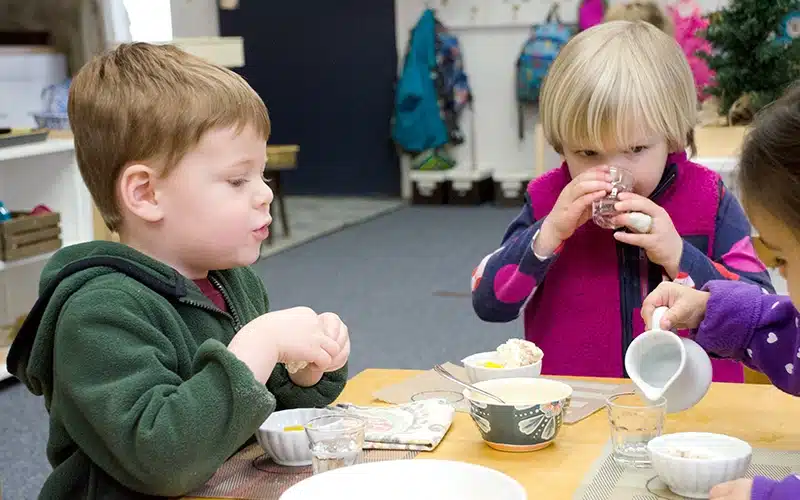
Conclusion
Creating a Montessori at Home environment is a journey that evolves with your child’s needs, interests, and growth. By thoughtfully preparing spaces and incorporating the principles of the Montessori Method, you can provide a nurturing setting where children of all ages thrive academically, socially, and emotionally.
Whether it’s designing a Montessori playroom for toddlers, setting up practical life activities for older children, or encouraging exploration through specialized learning zones, the essence of Montessori lies in fostering independence and a love for learning.
Through this process, you’re creating a learning environment and building a foundation for lifelong success. A well-implemented Montessori at Home program helps children develop adaptability, problem-solving skills, and self-confidence, empowering them to excel in all aspects of life.
Let your home become a sanctuary of curiosity, creativity, and growth, guided by the timeless principles of Montessori education. With the right tools, spaces, and mindset, every child can unlock their full potential in a supportive and enriching Montessori-friendly environment.













